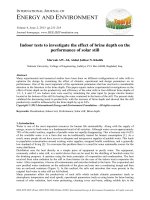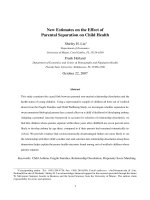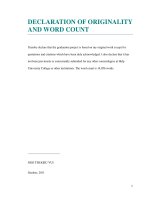The effect of government spending on macroeconomic stability
Bạn đang xem bản rút gọn của tài liệu. Xem và tải ngay bản đầy đủ của tài liệu tại đây (227.22 KB, 6 trang )
Accounting 2 (2016) 31–36
Contents lists available at GrowingScience
Accounting
homepage: www.GrowingScience.com/ac/ac.html
The effect of government spending on macroeconomic stability
Keyvan Karimia*, Rahebe Ghasemzadeb, Payam Khodaeia and Payam Abdic
a
Department of Accounting, Shahindezh Branch, Islamic Azad University, Shahindezh, Iran
Department of Computer Science, Shahindezh Branch, Islamic Azad University, Shahindezh, Iran
Department of Management, Shahindezh Branch, Islamic Azad University, Shahindezh, Iran
b
c
CHRONICLE
Article history:
Received June 5, 2015
Received in revised format
August 16 2015
Accepted December 21 2015
Available online
December 22 2015
Keywords:
Macro-economy stability
The Johansen-Juselius method
Government spending
ABSTRACT
Macroeconomic stability plays essential role on the performance of governments and attaining
economic development. Therefore, governments can displace the demand curve and achieve
different goals such as economic development and growth by considering financial
instruments, which are available for them. Thus, the present study aims at investigating the
effect of government spending on the stability of macro-economy for the time interval 19792011 using the Johansen-Juselius method. The results indicate that the variables of goods price
index and services as well as government investment spending had positive effects and
variables of exchange free rate, government consumption spending, and government tax
revenues had negative effects on economic development.
© 2016 Growing Science Ltd. All rights reserved.
1. Introduction
The necessity and significance of macroeconomic stability has been the focus of several economists
after the presentation of a report by the World Bank in 1991. Macroeconomic stability has important
signs on the orientation of macroeconomic policies, monetary and financial credit of a country for
economic agents. Particularly, the success of all programs of amending the economic structure such as
financial reformations, modification policies, making free and purposive energy subsides require the
existence of macroeconomic stability. Consequently, there is a significant correlation between
economic development and macroeconomic stability of a country. Accordingly, in the present study,
after the introduction section, the theoretical framework is investigated. Then, the proposed
methodology of this paper is explained and data analysis is discussed. Finally, conclusion is presented
to summarize the contribution of the paper.
* Corresponding author.
E-mail address: (K. Karimi)
© 2016 Growing Science Ltd. All rights reserved.
doi: 10.5267/j.ac.2015.12.006
32
2. Theoretical framework and review of literature
The necessity and significance of macroeconomic stability has been at the focus of economists’
attention after the presentation of a report given by the World Bank in 1991. In this report which
investigated the performance of countries in 70’s and 80’s, it was indicated that countries with
economic stability had better coordination in governments’ policies than instable countries (World
Bank, 1991). After the attention of the World Bank to the significance of economic stability, some
economists have investigated the effects of government policies on economic development (Levine &
Renelt, 1991, 1992; Ghura & Hadjimichael, 1996; Orden & Fisher, 1993). According to Gorji and
Madani (2003), macroeconomic stability increases national saving and private investment and, by
reinforcing competitions in export, improves balance of payments. In addition, macroeconomic
stability pursues important signs regarding the orientation of macroeconomic policies and monetary
and financial credit in a country for economic agents. Particularly, the success of all programs of
amending the economic structure such as financial reformations, modification policies, making free
and purposive energy subsides requires the existence of macroeconomic stability (Khalili Araghi &
Ramzanpour, 2002). Consequently, there is a significant correlation between economic development
and macroeconomic stability of a country in such a way that macroeconomic stability results in the
trust of economic activists in future upheavals and consequently draws a clear vision of the future.
Therefore, macroeconomic stability can contribute significantly to the real economic development. In
addition, macroeconomic stability as one of the factors in economic development, particularly was
considered (Frenkel & Khan, 1990; Easterly & Rebleu, 1993).
Studies conducted by International Monetary Fund indicate that economic instability is the main factor
of stagnation in most of countries. Therefore, it is expected that the adoption of plans for making
macroeconomics stable and structural reformations can be effective on the access to high economic
development (Norouzi, 2001). In addition, regarding the fact that one of the important economic sectors
in each country is the government which, in addition to providing security based on the viewpoint of
the minimum government intervention, can play significant role on economic management and
production. Accordingly, it can have negative and positive effects on the production of the private
sector and, at last, the total economic production (Doessel & Valadkhani, 2003). Doing the mentioned
activity and playing roles imposed by the government necessitate spending and since one of the
measurement criteria of the government is not available in the literature, government spending is
associated with the growth domestic products (GDP); therefore, the significant intervention of
governments in economy implies that the appropriate role and size of governments are challenging
arguments among economists and statesmen (Gholami, 2009).
Regarding the investigation of government size on the economic development in empirical literature,
there are some findings, which are contradictory and the positive effect of government size on economic
development is indicated (Ram, 1986; Kormendi & McGuire, 1985; NORAD, 2000), while Lando
(1994), Cameron (2002) and Khalili Araghi and Ramzanpour (2002) believe that government spending
has negative effects on economic development.
Accordingly, a general law and principle for the relationship between government size and economic
development in different countries cannot be presented and the findings in one country cannot be
generalized to another one. The relationship between government spending and economic development
is not clear in economic theories. However, it is expected that by creating required infrastructure and
providing services appropriately and efficiently, governments contribute to economic development
(Komeijani & Nazari, 2009). Therefore, governments can displace the demand curve using financial
instrument available for them and accordingly, they can obtain important objectives such as production
development or the reduction in employment, curbing inflation, and economic stability. In this line,
financial policies refers to a set of measures of governments regarding government spending, taxes and
transfer payments, which can be applied to attain the mentioned objectives. Therefore, financial policies
as active elements of macroeconomics, construct a revolution initiated by Keynes in economics. Before
K. Karimi at al. / Accounting 2 (2016)
33
him, classists believed basically in the necessity of government intervention in economy. The main
issue in Keynes’ ideas is associated with the expansion of governments’ activities in government
productive, economic, and investment affairs for attaining complete employment level. In this line, the
direct effect of each kind of financial policy will be transition curve. Some Iranian researchers
investigated the effects of government spending on economic development using the Autoregressive
Distributed Lag (ARDL) models. Their results indicated that the increase in government’ construction
expenditures had direct and significant effects on economic development, but government’
consumption expenditure had no significant effect on economic development. Rahbar and Sargolzaei
(2011), in a study investigated the effect of government spending on economic development from 1984
to 2007 using the ARDL and VAR models. The results indicated that the increase in government’s
consumption spending in short-term period results in the decrease in economic development rate.
Komeijani and Nazari (2009), using the Auto-regression Model, investigated the effect of government
size on the economic development in Iran. They concluded that the effect of government spending on
economic development was positive and compatible with the Keynes’ economic theory. Kandil (2001)
investigated the effects of the contractionary and expansionary shock shocks of financial policies on
economic development for USA during 4/1998 to 1/1987 using the Hodrick-Prescott (HP) filter. The
results of the present study indicated that the contraction and expansion shocks of financial policies in
a government was a sustainable process predicted during the time period. Berument and Dogan (2004)
in their study investigated the asymmetrical effect of government spending shocks on the production
of Turkey for the time period from 1/1987 to 1/2000 using the Hodrick-Prescott (HP) filter. The results
indicated that private consumption and investment reduce in spite of government expansionary shock,
while the occurrence of contractionary shocks, no reduction in private consumption and investment.
Tagkalakis (2008) investigated the asymmetrical effect of financial policies on the private consumption
during business cycles of boom and bust for 19 countries of OECD) from 1970-2002 using the panel
data method. The results indicated that the effect of financial policies on the private consumption in the
periods of recession more than period of prosperity.
3. Methodology
In the present study, using the theoretical framework and empirical studies, i.e. the ARDL and VDCF
models in the time period from 1959 to 2003, the survey investigates the effects of financial policies
on economic development using the following regression function,
GDPR = F(CPIR, ERR, GCR, GDPR, GIR, TTR),
where GDPR, TTR, GCR, GIR, CPIR and ERR represent gross domestic product, tax revenues growth,
government consumption expenditure growth, the growth of government investment expenditure,
goods and services consumer price index growth, market exchange rate growth, respectively.
In addition, in the present study, to estimate the model, the Johansen-Juselius convergence method
using the Eviews 7 software has been employed. In this method, first the reliability of the variables of
the model was investigated and then, the optimization of the VAR model was determined by the SBC
test. The reason for using the Johansen-Juselius convergence method instead of other convergence
methods is that this method has been considered more than a convergence vector among the model
variables and in case of using this method, estimators will have asymptotic efficiency. Accordingly, to
estimate the long-term relations among variables, the Johansen-Juselius convergence method has been
used. Johansen-Juselius, by formulizing a method for the vector cointegration, could remove the
deficiencies of the Engle–Granger two-step method. In addition, to investigate the reliability of
variables, the Augmented Dickey-Fuller test (Table 1) or the Phillips–Perron test has been used
(Gujarati, 2012). In the next stage, it is necessary that the existence or absence of the number of
convergence vectors be investigated using the matrix effect test and the maximum eigenvalues. To do
so, two statistics of the maximum of eigenvalues (Table 3, 4) and the effect test were used (Tashkini,
2009). The selected optimal vector has been investigated. Finally, to analyze data and estimate the
model, the vector auto-regression (VAR) (Table 2) has been employed.
34
Table 1
The results of the Augmented Dickey-Fuller test and Phillips–Perron test
Variable name
lnCPI
The ADF test
At level and intercept
One-stage
and temporal trend
differencing and
with intercept
-2.05
-3.90
The PP test
Two-stage
At level and intercept
One-stage
Two-stage
differencing and and temporal trend
differencing and differencing and
with intercept
with intercept
with intercept
-1.68
-3.84
-3.55
-2.95
-
MacKinnon critical values at
Sig. 5%
LnERR
MacKinnon critical values at
Sig. 5%
LnGCR
-3.55
-2.95
-2.75
-3.55
-2.86
-2.95
-6.12
-2.96
-2.38
-3.55
-2.78
-2.95
-6.63
-2.95
-2.33
-5.04
-
-2.48
-5.11
-
MacKinnon critical values at
Sig. 5%
lnGIR
-3.56
-2.95
-
-3.54
-2.95
-
-2.53
-2.01
-8.76
-2.29
-4.90
-
MacKinnon critical values at
Sig. 5%
lnGDP
-3.56
-2.96
-2.96
-3.54
-2.95
-
-2.47
-4.22
-
-2.09
-4.25
-
MacKinnon critical values at
Sig. 5%
lnTTR
-3.56
-3.95
-
-3.55
-2.95
-
-2.04
-5.02
-
-2.80
-5.02
-
MacKinnon critical values at
Sig. 5%
-3.55
-2.95
-
-3.55
-2.95
-
Table 2
The number of optimal lags in the VAR model
Schwartz-Bayesian test values (SBC)
Number of lags
-10.68
0
-18.22*
1
-16.13
2
-17.42
3
Table 3
Matrix effects test
Null hypothesis
r = 0*
r = 1*
r = 2*
r = 3*
r = 4*
Opposite hypothesis
r=1
r=2
r=3
r=4
r=5
Test values
227.04
119.71
75.50
41.37
24.23
Critical value at 95%
103.84
76.97
54.07
35.19
20.26
Probability value at level 95%
0.0000
0.0000
0.0003
0.0095
0.01354
Test values
107.32
44.21
34.13
17.14
16.34
Critical value at 95%
40.95
34.80
28.58
22.29
15.89
Probability value at level 95%
0.0000
0.0029
0.0088
0.2247
0.0424
Table 4
The results of maximum eigenvalues
Null hypothesis
r = 0*
r = 1*
r = 2*
r=3
r = 4*
Opposite hypothesis
r=1
r=2
r=3
r=4
r=5
Table 5
Estimating convergence vectors
Variable test
logGDP*
logCPI
logERR
logGCR
logGIR
logTTR
Coefficient
1
1.28
-0.66
-0.15
0.92
-1.24
SD
0
0.20
0.05
0.40
0.12
0.08
T student test values
0
6.4
-13.2
0.375
7.66
15.5
* convergence vector has been normalized in relation with the variable logGDP.
**regarding the fact that the Johansen – Juselius method does not show the probability values; therefore, the significance of the coefficient explanatory
variables of the values of t-student was used.
35
K. Karimi at al. / Accounting 2 (2016)
Results of Table 5 indicate that the CPI and GIR have had positive and significant effects on economic
development in such a way that per variation as one percent in the CPI, the economic development of
the country will be as 1.28%. Accordingly, regarding the government’s investment spending, per
variation as one percent in the GIR, there will be 0.92 % of economic development. In addition, the
ERR, GCR, and TTR have had negative effects on economic development in such a way that the ERR
had 0.66% of negative effect on economic development due to one percent variation. The GCR had
0.15% percent of negative effect on economic development per one percent variation. Accordingly, per
one percent variation in the TTR, the economic development faces the lack of development as 1.24
percent.
Table 6
The results of estimating the VECM model
Variable name
Coefficient
SD
-0.152750
GDP(-1 )
t-student value
-0.10723
-1.42451
Table 7
Analysis variance for levels of inflation in the 10 periods
The TTR shock
share
0
1
1
0.2
0.5
0. 6
0.7
0.8
0.9
1
The GIR shock
share
0
5
5
4
4
4
5
5
5
5
The GCR shock share
0
The ERR shock share
0
4
9
10
9
10
10
10
10
10
9
15
21
23
23
23
23
24
24
The CPI shock share The GDP shock share
0
0.2
3
0.8
6
9
10
11
11
12
100
81
66
64
57
53
51
50
49
48
Period
1
2
3
4
5
6
7
8
9
10
According to Table 7, the most affectedness of the GDP in the first period was from the variations of
the variable itself and this trend has been reduced during the 10 year period. In addition, the CPI in the
second period has been effective as 0.2 and in the third period as 3 percent on the GDP and this trend
has been increased in the fourth period in such a way that in the tenth period, it has reached its peak.
Accordingly, regarding the GCR, it has been effective on the GDP as 4% in the second period, where
this value has increased up to the fourth period and in the fifth period, it has increased with one unit in
relation with the fourth one and continued its fixed trend up to the tenth period.
4. Conclusion
In the present study, the effect of the government spending on the macroeconomic stability has been
investigated. Regarding the significance of macroeconomic stability and the issue that in countries
enjoying economic stability, governments have had better performance than countries suffering
instability; therefore, parallel to macroeconomic development and the effect of government
intervention in the process of economic development increase, but regarding the theoretical framework,
a general law cannot be considered for the relationship between movement size and economic
development. As a result, governments, regarding their financial instruments, can displace the demand
curve and obtain economic development and stability. In addition, regarding the theoretical framework
and conducted studies, the most variability in the GDP was in the first period of the variable itself and
this trend decreased for the next periods. Furthermore, the CPI and GIR had positive effects and the
ERR, GCR and TTR had negative effects on the trend of economic development.
36
Acknowledgement
The authors would like to thank the anonymous referees for constructive comments on earlier version
of this paper.
References
Berument, H., & Dogan, B. (2004). The asymmetric effects of government spending shocks: empirical
evidence from Turkey. Journal of Economic and Social Research, 6(1), 33-51.
Cameron, A. D. (2002). Importance of early selective thinning in the development of long‐term stand
stability and improved log quality: a review.Forestry, 75(1), 25-35.
Doessel, D. P., & Valadkhani, A. (2003). The effect of government on economic growth in Fiji. The
Singapore Economic Review, 48(01), 27-38.
Easterly, W., & Rebelo, S. (1993). Fiscal policy and economic growth.Journal of monetary
economics, 32(3), 417-458.
Frenkel, J. A., & Khan, M. S. (1990). Adjustment policies and economic development. American
Journal of Agricultural Economics, 72(3), 815-820.
Gorji, E., & Madani, Sh. (2003). Investigating the role of economic stability, economic growth
performance with simultaneous equations. Journal of Commerce, 28, 24.
Gholami, E. (2009). Evaluation price shocks of oil revenues on tax revenues in Iran. Institute of
Economic Affairs and Finance, a research project.
Ghura, D., & Hadjimichael, M. T. (1996). Growth in Sub-Saharan Africa. Staff Papers-International
Monetary Fund, 605-634.
Gujarati, D. N. (2012). Basic econometrics. Tata McGraw-Hill Education.
Kandil, M. (2001). Asymmetry in the effects of US government spending shocks: Evidence and
implications. The Quarterly Review of Economics and Finance, 41(2), 137-165.
Khalili Araghi, M., & Ramzanpour, E. (2002). The importance of macroeconomic stability. Economic
Research Journal, 36(1).
Komeijani, A. et al. (2014). Examining the size and quality of the economic growth in Iran as co ARDL,
Volume 4.
Komeijani, A., & Nazari, R. (2009). Examining the size the state's economic growth. Economic
Research Journal, 4(2).
Kormendi, R. C., & Meguire, P. G. (1985). Macroeconomic determinants of growth: cross-country
evidence. Journal of Monetary Economics, 16(2), 141-163.
Lando, D. (1994). Three essays on contingent claims pricing. Cornell University, May.
Levine, R., & Renelt, D. (1991). Cross-country studies of growth and policy: methodological,
conceptual, and statistical problems (Vol. 608). World Bank Publications.
Levine, R., & Renelt, D. (1992). A sensitivity analysis of cross-country growth regressions. The
American Economic Review, 942-963.
NORAD (1995). Guide to Planning and Evaluation NGO Projects, Number 2: Core Elements in
Planning Development Assistance, Oslo: NORAD.
Norouzi, H. (2001). Effects of instability on economic growth in Iran (with the focus on inflation). MSc
Thesis, Shahid Beheshti University.
Orden, D., & Fisher, L. A. (1993). Financial deregulation and the dynamics of money, prices, and
output in New Zealand and Australia. Journal of Money, Credit and Banking, 25(2), 273-292.
Rahbar, F., & Sargolziei, M. (2011). The impact of fiscal policy on economic growth and poverty
during the period 1984 to 2007. Economic Research Journal, 46(96).
Ram, R. (1986). Government size and economic growth: A new framework and some evidence from
cross-section and time-series data. The American Economic Review, 76(1), 191-203.
Tagkalakis, A. (2008). The effects of fiscal policy on consumption in recessions and
expansions. Journal of Public economics, 92(5), 1486-1508.
Tashkini, A. (2009). Econometrics with the help of Microfit. Tehran: Tehran Dibagaran publication.









